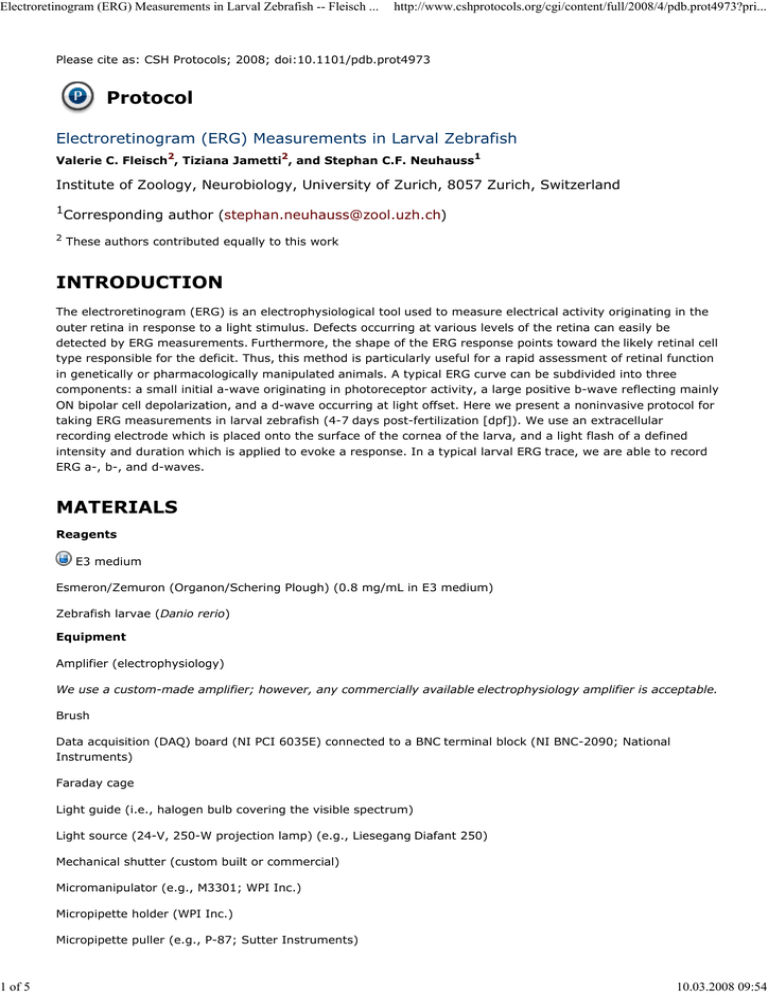
Electroretinogram (ERG) Measurements in Larval Zebrafish -- Fleisch ...
1 of 5
http://www.cshprotocols.org/cgi/content/full/2008/4/pdb.prot4973?pri...
Please cite as: CSH Protocols; 2008; doi:10.1101/pdb.prot4973
Protocol
Electroretinogram (ERG) Measurements in Larval Zebrafish
Valerie C. Fleisch2, Tiziana Jametti2, and Stephan C.F. Neuhauss1
Institute of Zoology, Neurobiology, University of Zurich, 8057 Zurich, Switzerland
1
Corresponding author (stephan.neuhauss@zool.uzh.ch)
2
These authors contributed equally to this work
INTRODUCTION
The electroretinogram (ERG) is an electrophysiological tool used to measure electrical activity originating in the
outer retina in response to a light stimulus. Defects occurring at various levels of the retina can easily be
detected by ERG measurements. Furthermore, the shape of the ERG response points toward the likely retinal cell
type responsible for the deficit. Thus, this method is particularly useful for a rapid assessment of retinal function
in genetically or pharmacologically manipulated animals. A typical ERG curve can be subdivided into three
components: a small initial a-wave originating in photoreceptor activity, a large positive b-wave reflecting mainly
ON bipolar cell depolarization, and a d-wave occurring at light offset. Here we present a noninvasive protocol for
taking ERG measurements in larval zebrafish (4-7 days post-fertilization [dpf]). We use an extracellular
recording electrode which is placed onto the surface of the cornea of the larva, and a light flash of a defined
intensity and duration which is applied to evoke a response. In a typical larval ERG trace, we are able to record
ERG a-, b-, and d-waves.
MATERIALS
Reagents
E3 medium
Esmeron/Zemuron (Organon/Schering Plough) (0.8 mg/mL in E3 medium)
Zebrafish larvae (Danio rerio)
Equipment
Amplifier (electrophysiology)
We use a custom-made amplifier; however, any commercially available electrophysiology amplifier is acceptable.
Brush
Data acquisition (DAQ) board (NI PCI 6035E) connected to a BNC terminal block (NI BNC-2090; National
Instruments)
Faraday cage
Light guide (i.e., halogen bulb covering the visible spectrum)
Light source (24-V, 250-W projection lamp) (e.g., Liesegang Diafant 250)
Mechanical shutter (custom built or commercial)
Micromanipulator (e.g., M3301; WPI Inc.)
Micropipette holder (WPI Inc.)
Micropipette puller (e.g., P-87; Sutter Instruments)
10.03.2008 09:54
Electroretinogram (ERG) Measurements in Larval Zebrafish -- Fleisch ...
2 of 5
http://www.cshprotocols.org/cgi/content/full/2008/4/pdb.prot4973?pri...
Microscope (binocular, containing light source equipped with infrared filter) (e.g., Zeiss Stemi SV8)
Neutral density filter wheels (two filter wheels covering five log units)
Unattenuated light intensity over the larval head is 3100 lux (optical density [OD] is equal to 0 log unit), as
measured by a light meter (Tekronix J17).
Oscilloscope (e.g., HM408; HAMEG) or computer and customized recording software (e.g., LabVIEW Virtual
Instrument [VI])
Petri dish (35-mm diameter)
Preamplifier (general purpose AC) (e.g., P55; GRASS Technologies)
Recording electrode (borosilicate glass micropipette) (e.g., 300016; Harvard Apparatus Ltd.), with a tip diameter
of 15-30 µm
Reference electrode (Ag/AgCl pellet) (e.g., HLA-003; Molecular Devices)
Sponge or other fluid-absorbent material (35-mm diameter, to fit Petri dish)
Stimulator (general purpose) (Master-8; A.M.P.I.)
Syringe
Tissue
METHOD
Recording Setup Assembly
An assembled recording setup is shown in Figure 1 . Recordings should be performed inside a Faraday cage to
reduce electrical noise.
Figure 1. (A) Schematic drawing of the ERG setup, including relevant
technical components. (B) Close-up picture of the placement of the
zebrafish larva in the setup; inset shows positioning of recording
electrode on the cornea of the larva.
View larger version (46K):
[in this window]
[in a new window]
1. Connect the light source to the light guide, the neutral density filter wheels and the mechanical shutter.
Neutral density filter wheels are used to adjust the desired light intensity. The shutter is controlled by
computer-based software (Master-8 software; A.M.P.I.).
2. Connect both the recording electrode and the reference electrode to the amplifier via the preamplifier.
Preparation of the recording electrode is described in Step 5.
3. Connect the amplifier to the oscilloscope and the DAQ Board.
10.03.2008 09:54
Electroretinogram (ERG) Measurements in Larval Zebrafish -- Fleisch ...
3 of 5
http://www.cshprotocols.org/cgi/content/full/2008/4/pdb.prot4973?pri...
4. Set up a binocular microscope, to be used for positioning of the larvae.
Preparation of Electrodes
5. Prepare a recording electrode (micropipette) with the desired tip diameter (15-30 µm) using a
micropipette puller.
Using the P-87 puller, we employ the following parameters: heat = 367, pull = / , velocity = 16, time =
250, pressure = 500. However, these parameters will vary extensively depending on the type of puller
(and filament) used.
Make sure that the tip diameter is correct and that the tip end is smooth and not damaged. Tips do not
need to be flame-polished.
6. Fill the micropipette with E3 medium using a syringe, and attach it to the micropipette holder.
7. Attach the micropipette holder to the micromanipulator.
8. Place a sponge or other fluid-absorbent material (35 mm in diameter) in a 35-mm Petri dish. Fix the
reference electrode to the Petri dish containing the sponge. Place the pellet of the reference electrode in
the center of the binocular microscope’s visual field.
9. Place a piece of tissue onto the reference electrode.
10. Moisten the sponge and the tissue with E3 medium.
Placement of Larva
In order to minimize bleaching of the visual pigment, always work under red illumination.
11. Adapt larvae to the dark for a minimum of 30 min. Place a single larva onto the pellet of the reference
electrode using a brush. Orient the larva such that one eye is directed to the light beam.
12. Paralyze the larva with a drop of Esmeron.
13. Position the recording electrode on the center of the cornea using the micromanipulator.
The recording electrode should just slightly touch the eye; do not insert the electrode into the eye.
14. Position the light guide such that the light beam is directed at the larval head.
Standard Measurement Recording
An example of an ERG trace is shown in Figure 2 .
Figure 2. Typical ERG trace of a wild-type zebrafish (5 dpf)
(stimulus time 1 sec, acquisition time 2 sec). The depicted trace
is an averaged curve of five measurements (which we perform
as a standard) recorded from one larva (light intensity 6000
lux).
View larger version (10K):
[in this window]
[in a new window]
15. Turn on all components of the setup equipment.
16. Adjust the desired light intensity using the neutral density filter wheels.
During standard recordings, shut off all external light sources (including the infrared light). If desired,
recordings can also be done under different background illumination levels.
10.03.2008 09:54
Electroretinogram (ERG) Measurements in Larval Zebrafish -- Fleisch ...
4 of 5
http://www.cshprotocols.org/cgi/content/full/2008/4/pdb.prot4973?pri...
17. To take standard measurements, use a stimulus duration of 100-1000 msec and an acquisition time of
1000-2000 msec, depending on the stimulus duration.
A 100-msec stimulus is sufficient for eliciting a- and b-waves; a longer stimulus duration (of 1000 msec) is
required for recording a d-wave.
We use a scan rate of 1000 Hz and a bandpass of 1-100 Hz for all recordings.
The total signal amplification of the amplifier and preamplifier equals 1000X.
18. Observe recordings on the oscilloscope, or alternatively use a computer and customized recording
software (e.g., LabVIEW VI).
See Troubleshooting.
19. To produce an averaged curve, repeat measurements five times with a defined interstimulus interval
of 5000-7000 msec (Fig. 2).
The interstimulus interval can be adjusted as desired; if recordings are done using different light
intensities, intervals can be longer to gain time for turning the filter wheels.
TROUBLESHOOTING
Problem: A measurable electrical response occurs without a sample.
[Step 10]
Solution: This is due to the photovoltaic effect of an oxidized reference electrode. Confirm that the reference
electrode shines brightly metallic. If not, clean it carefully with fine grinding paper. This should abolish the
photoelectric response.
Problem: Irregular waves (e.g., several peaks) are observed.
[Step 18]
Solution: There may be a defect in the recording electrode, such as an end that is not smooth or a narrow tip.
Change the recording electrode.
Problem: Small b-wave amplitude (<150 µV) is observed, even with bright light.
[Step 18]
Solution: Confirm that the recording electrode is well positioned on the center of the cornea and remove any
surplus E3 medium on the sponge. Alternatively, change the recording electrode.
Problem: High background noise affects measurement.
[Step 18]
Solution: Consider the following:
Make sure that all components of the setup are properly grounded. This may require adjustment during
the initial setup.
Place a metal grid in front of the whole assembly to reduce noise (Fig. 1).
Use a 50-Hz filter on the amplifier.
A recording electrode with a small opening diameter also produces electrical noise; use an electrode with a
tip diameter of at least 15 µm.
DISCUSSION
The ERG setup described here can be used to measure ERG responses of larval zebrafish, as well as Medaka
larvae and tadpoles of Xenopus laevis (Makhankov et al. 2004). Moreover, it can be easily adapted for
10.03.2008 09:54
Electroretinogram (ERG) Measurements in Larval Zebrafish -- Fleisch ...
5 of 5
http://www.cshprotocols.org/cgi/content/full/2008/4/pdb.prot4973?pri...
measurements of adult zebrafish (with use of an oxygenation chamber) and other aquatic species. Larval
zebrafish begin to show reliable ERG responses at 4 dpf. It is important to keep in mind that all responses
measured in these larvae are cone-driven responses, since rods do not contribute to the ERG response until 15
dpf. Therefore the larval retina during this time span is considered to be functionally cone-dominant (Branchek
1984; Bilotta et al. 2001).
The use of specialized recording software (e.g. LabVIEW VI) allows creation of different paradigms (e.g.,
bleaching, double flash paradigm, etc.), which can be enormously useful in addressing specific biological
questions of interest.
ACKNOWLEDGMENTS
Our work is supported by grants from the EU (ZF Models), the Swiss National Science Foundation, and the
Neuroscience Center Zürich. We thank Mathias Seeliger for our initial ERG recordings, Yuri Makhankov for
building the current setup, and Thomas Labhart for perfection of the setup and technical help.
REFERENCES
Bilotta, J., Saszik, S., and Sutherland, S.E. 2001. Rod contributions to the electroretinogram of the dark-adapted
developing zebrafish. Dev. Dyn. 222: 564–570.[Medline]
Branchek, T. 1984. The development of photoreceptors in the zebrafish, brachydanio rerio. II. Function. J.
Comp. Neurol. 224: 116–122.[Medline]
Makhankov, Y.V., Rinner, O., and Neuhauss, S.C. 2004. An inexpensive device for non-invasive
electroretinography in small aquatic vertebrates. J. Neurosci. Methods 135: 205–210.[Medline]
Recipe
E3 medium
5 mM NaCl
0.17 mM KCl
0.33 mM CaCl2
0.33 mM MgSO4
0.1% methylene blue (Sigma)
Copyright © 2008 by Cold Spring Harbor Laboratory Press. Online ISSN: 1559-6095 Terms of Service All rights reserved.
Anyone using the procedures outlined in these protocols does so at their own risk. Cold Spring Harbor Laboratory makes no
representations or warranties with respect to the material set forth in these protocols and has no liability in connection with
their use. All materials used in these protocols, but not limited to those highlighted with the Warning icon, may be considered
hazardous and should be used with caution. For a full listing of cautions, click here.
All rights reserved. No part of these pages, either text or images, may be used for any reason other than personal use.
Reproduction, modification, storage in a retrieval system or retransmission, in any form or by any means-electronic,
mechanical, or otherwise-for reasons other than personal use is strictly prohibited without prior written permission.
CiteULike
Connotea
Del.icio.us
Digg
Reddit
Technorati
What's this?
10.03.2008 09:54



